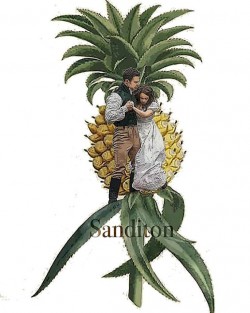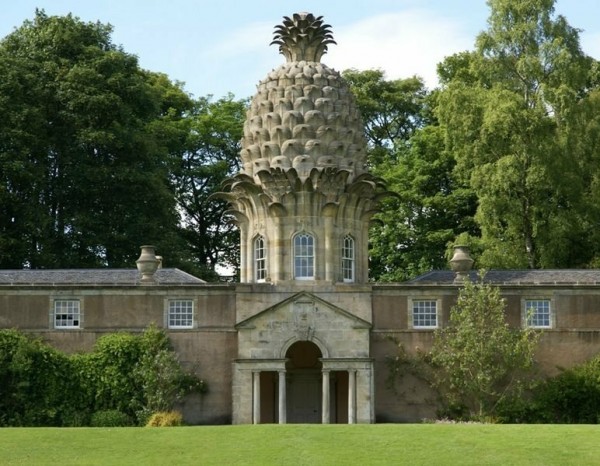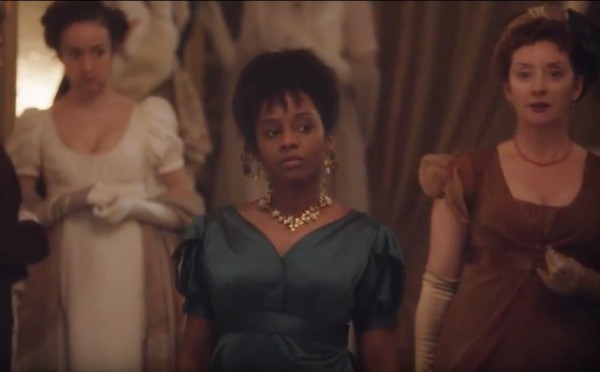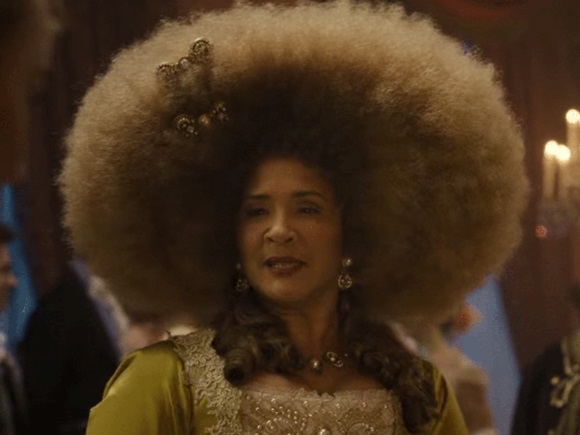So, Lady Denham thinks that being polite is showing Georgiana ‘Oh, I have a pineapple.’” These words, by the Den of Geek writer and woman of color Amanda-Rae Prescott in a panel interview for Fansplaining.com, reveal the heart of the problem with the pineapple emoji controversy that occurred in 2019 and 2020. This controversy began when many Sanditon fans, in the effort to show support for the ITV/PBS show, started using the pineapple emoji as a symbol of their love and devotion. What many fans failed to realize, and what Prescott alerted these Sanditon followers to, was that the use of the emoji was extremely offensive to Black fans of the show, of Austen, and of the Regency period. For Black fans as well as some others, the offense was quite clear. The use of the pineapple as an emoji, in all of its cuteness, trivialized the commentary about British slavery and colonialism that Andrew Davies, creator of the series, intended. The response to Prescott’s admonishment was also quite clear. Many Sanditon fans did not appreciate the rebuke. According to Prescott, many Sanditon fans retaliated by accusing her of “bullying,” “ruining the fandom spirit,” and “high-jack[ing] control of the narrative” (Klink and Minkel). The real issue not perceived by Sanditon fandom when their seeming politeness (i.e., their support of the show through the pineapple emoji) was called out for its undertones of racism was similar to Lady Denham’s faux outrage at the “effrontery” of Miss Lambe’s response to “her” pineapple. In other words, the story of the pineapple is not theirs to tell, to own, or to be offended by.

Image owned by Genevieve Corinne, Instagram.
That said, my feelings of being trespassed against by the use of the pineapple emoji are light in comparison with the alarm arising from my research into the reasons why some Regency fans still find no offense in the use of the pineapple emoji and the codes of racism and classism it represents. Despite all the calls to Regency fandom for diversity and inclusiveness since the initial pineapple uproar and its resurgence (highlighted by the racial unrest caused by the murder of George Floyd), my search for answers has developed into a disappointing realization. The pineapple emoji may never be recognized as an offensive symbol for a number of reasons: many Regency fans still wish to celebrate British Colonialism; many Regency fans still want to deny the hurt British Colonialism has wrought; and many Regency fans at least unconsciously cling to the idea that the works of Jane Austen and other Regency authors belong only to non-people of color.
The history of the pineapple and the British Empire
The pineapple, also known as ananas or the “excellent fruit” was the native creation of the region of South America that today includes the countries of Brazil and Paraguay. By the fifteenth century, pineapples were making their way to other tropical climates, thanks to the importing skills of the Dutch and the Portuguese (Cotti-Lowell 212). Late sixteenth century Spain introduced the pineapple as “piña” (pine) to England, where it was soon designated as a symbol of royalty—even bearing the name “King Pine” (Booth). Furthermore, King Charles II of England commissioned a portrait of himself by the artist Hendrick Danckerts that showed him receiving a pineapple as a gift (Bell). As the pineapple became a symbol of luxury and status in England, images of pineapples were placed on carriages, doormats, Wedgwood tea service sets, and anything that could bear them (Bell).

Charles II Presented with a Pineapple, by Hendrick Danckerts (1675–1680). Royal Collection Trust.
© Her Majesty Queen Elizabeth II
Another example of luxury and status that the pineapple presented can be seen in the architecture of The Dunmore Pineapple House, a hothouse built in 1761 in Scotland in the shape of a pineapple—like others built in order for the wealthy beneficiaries of the Empire to be able to grow their own pineapples (Bell). Later in the century, Regency hostesses kept the doors to the dining room closed to “heighten visitors’ suspense” about the evening’s festivities. The “pineapple-topped food displays” expressed a hostess’s desire to impress and please her guests, who would feel “particularly honored by a hostess who obviously spared no expense” (Levins).

The enormous expense of pineapples during that time was due to the need to import them from the colonized West Indies, as the building of hothouses would not begin until later. In the sixteenth century, pineapples were seen hanging from the home entrances of Caribbean natives as a sign of welcome to the Imperialist travelers who would later become their masters (Weissman). In the process of exporting pineapples from the Caribbean, this connotation of hospitality was also transported to England despite the ironic racial undertones. The association of the pineapple with hospitality can also be traced to the colonies of North America in the mid-eighteenth century. Seen by most people living in the twenty-first century, according to C. S. Manegold, as a “benign” and “happy story” of welcome (qtd. in Latour), the true understanding of the pineapple as a symbol of welcome was lost. What is obscured in our contemporary celebration of the pineapple is that, in colonial America, the pineapple was also used as a signal by New England captains that they were home, bearing “the bounty of slave labor and sometimes slaves themselves” (Latour).
Jane Austen herself recognized the pineapple as a symbol of wealth and servitude. As Christopher Natali shows, in Northanger Abbey General Tilney’s wealth is established through the mention of his “village of hot-houses” which produced his own pineapples. General Tilney mentions that the hothouses “‘yielded only one hundred [pineapples] in the last year’” (NA 182–83). Since the cost for the production of one pineapple was £80, the total cost to produce General Tilney’s 100 pineapples would be £8000 over the three-year period it took each to grow (Natali). Natali reads the pineapple as a symbol of servitude as it is beneficial for the master alone and requires twenty-four-hour regulation of the hothouses. This work arrangement, where there is no other husbandry or farming being accomplished, Natali speculates, “leave[s] these laborers at the mercy” of the master’s will for wages to satisfy their daily needs for meat, bread, housing, etc. Natali concludes that Austen is critical of this arrangement since the community of servants and employees is there “merely to satisfy the General’s desires.”
The role of the pineapple in Davies’s Sanditon
Jane Austen began to write Sanditon, her final, incomplete novel, in January 1817. On her arrival at Sanditon, a new seaside resort, as a guest of Mr. and Mrs. Thomas Parker, Charlotte Heywood is introduced to the inhabitants of the town, including Lady Denham. Charlotte hears about a group of young ladies chaperoned by Mrs. Griffiths, including a Miss Lambe, a biracial, sickly, young woman from the West Indies, who will be the target of Lady Denham’s needy nephew Edward Denham. In the last pages of the novel Charlotte catches a glimpse of Sydney Parker, brother of Mr. Parker.
There have been many attempts to finish Austen’s novel, including some excerpts published in Jane Austen: A Memoir (1871), written by her nephew James Edward Austen-Leigh. According to Davies, he “deliberately didn’t read any of the previous attempts” to complete Sanditon “so he would not be influenced by any other person’s work”—except by Austen herself (Reynolds).
Austen’s work, eleven to twelve chapters in the fragment, can be seen in the first half of the beginning episode of the ITV/PBS series. After that, it is all Davies, who gives Miss Georgiana Lambe, Austen’s only character who is a person of color, a name, a voice, and more significance than in the original novel, where she is literally “consigned to eternal narrative silence” with no identity (Salih 336). In the second episode, Miss Georgiana Lambe, arrives from the West Indies to be introduced to society. Lady Denham, a widow and the head of Sanditon society, hosts a luncheon and pineapple presentation in honor of the unusualness of Miss Lambe’s heritage. The purpose of this event is to encourage a match for her nephew, Edward, with Miss Lambe’s money. Lady Denham even goes so far as to encourage Edward to “hunt” down Miss Lambe as a potential wife.

Davies makes it clear that Miss Lambe is “someone to be reckoned with” (Nguyen), an interpretation very different from the Miss Lambe implied in Austen’s novel. In Davies’s series, Miss Lambe is upset by Lady Denham’s promotion of the greatness of the British Empire and its whiteness through the presentation of the pineapple. She is even more outraged when Lady Denham makes the suggestion that she should be used to the idea of being owned since her mother was a slave. Despite her wealth, Miss Lambe has no real power. Neither Lady Denham nor her guests care about her discomfort. Like the pineapple, Miss Lambe is a rare commodity to be placed on display and then, when her usefulness is complete, to be promptly relegated to her proper place. When Lady Denham’s pineapple is sliced opened, maggots escape, and Lady Denham’s horrid treatment of Miss Lambe reveals both Lady Denham’s rottenness and what Nguyen describes as “the slavery and exploitation inherent in the British presence in the West Indies.”
The whitewashing of Austen, Regency England, and Britain’s colonial past
With a grasp of the controversy of the pineapple emoji, the historical symbolism of the pineapple itself, and the role of the pineapple in Davies’s Sanditon, the central question of this essay can now be addressed: why do some Sanditon or Regency fans still see the pineapple emoji as inoffensive and refuse to connect it to the codes of racism and classism it represents? As I suggested earlier, there are a number of reasons. First of all, Regency fans still wish to celebrate the greatness of the British Empire, and the glory obtained through colonialism. According to a YouGov.com poll, thirty-two percent of British citizens, about one third of the nation (not just Regency fans), are proud of the Empire; thirty-seven percent of British people were neither proud nor ashamed of the history of the Empire (Booth). Although this statistic is disturbing, it is even more frightening that this poll occurred as late as 2020. Why do the British continue to wave their Union Jack flags and bellow the anthem “Rule, Britannia”? In my opinion, it is due, in part, to a misguided love that blinds them to the real history of the Empire.
Many people love to talk about the greatness of the British Empire and how Britain was both the catalyst for the end of slavery and the force to save Europe from Hitler. And yet, as the British journalist Afua Hirsch has pointed out, the very racism that found root in the United States for the past four hundred years was “invented . . . in Britain” (Hirsch). Hirsch also points out the collective amnesia on the subject of Winston Churchill, most often seen as an icon of British heroism in World War II. Churchill has been accused of believing in what John Charmley, author of Churchill: The End of Glory, calls “racial hierarchies and eugenics” (Heyden). In 1937, Churchill proclaimed, “I do not admit that a wrong has been done to these people [people of color in America and Australia] by the fact that a stronger race, a higher-grade race, a more worldly wise [i.e., white] race to put it that way, has come in and taken their place” (qtd. in Heyden). Despite the evidence of these racist beliefs, many people find the idea of discussing Churchill’s racial views to be “ludicrous” because he “spoke the language” of the Edwardian age and because he was one of the heroes of the twentieth century (Heyden).
What is the connection between this misguided love for the Empire and the celebration of the Empire’s greatness by Regency fans? Hanna Woodside’s recent article “The Empire Line Strikes Back” presents two groups of Regency fandom. The first group, the Jane Austen Pineapple Appreciation Society, also known as “the Pineapples,” explains that its name was based on a regency symbol of luxury and the exotic (Woodside). When asked about their reasons for dressing in the Regency manner, one member said, “it’s about the escapism” and “forgetting about your real life for a bit” (qtd. in Woodside). These may never be truly acceptable explanations for their choice as they ignore that the luxury and exotic associations of the pineapple were due in large part to the production of the fruit through slave labor and that the desire to escape the real world was not an indulgence that the slaves ever received. The second group, the Duke of Wellington Dancers, though not guilty of praising the pineapple, also finds the Regency period and the Empire romantic, despite their many dark aspects. When asked about historical accuracy, one member acknowledged that the group “get[s] to cherry-pick the lovely, glamorous bits” (qtd. in Woodside).
The pineapple emoji, then, is not only a tangible reminder of reverence for the British Empire but also a representation of denial of the hurt inflicted by the Empire. This indifference of the British people to colonialism, and specifically to the slave trade is depicted in Jane Austen’s Mansfield Park, in which the Bertrams reflect the values of society then and now in prioritizing the wealth produced in a colony like Antigua, where the pineapple eventually was transplanted. Fanny Price discusses with Edmund how she wanted to ask Sir Thomas Bertram more about the slave trade but that there was only “‘a dead silence’” (231).
This “dead silence” suggests the way that Britain’s history of colonialism and imperialism is today seriously ignored, if not completely denied. Similarly, if the pineapple’s connection to the continued glorification of the British Empire and the denial of its hurtful history does not prevent its use as a community identifier in discussing Sanditon or any Regency text, then the use of that symbol suggests that Jane Austen’s works and other Regency works are seen as not belonging equally to people of color. To return to Amanda-Rae Prescott’s history, when the racist associations of the pineapple emoji were called out by Prescott, the “Sanditon Sisterhood” basically accused her of being an inflammatory, discriminatory racist (Chua). How is it that a person of color who points outs racism becomes labeled as a racist? Their response seems to verify the notion that Sanditon and other works belong only to them.
There are several recent examples of the desire to whitewash history—that is, to suggest that only white people existed during a particular period of time—in order to maintain ownership. In 2019, the BBC One/FX production of A Christmas Carol featured Vinette Robinson, a British Jamaican, playing Bob Cratchit’s wife. When the series aired, comments across the social media ranged from the idea that Charles Dickens must be rolling over in his grave to “Fed up of this re-writing of British History” (qtd in Evans). The film The Personal History of David Copperfield (2019) starring Dev Patel appeared in theaters in 2020, another example of color-blind casting in an adaptation of a Dickens classic (i.e., casting without considering the actor’s ethnicity or skin color). Again, there were complaints. There were those who wondered if people would be worried if “Martin Luther King was played by a white man” (qtd. in Clarke) or why color-blind casting is praised when people of color play roles traditionally cast for white people but is frowned upon when the reverse occurs.

Bridgerton’s Queen Charlotte. © Netflix 2020.
The Netflix phenomenon Bridgerton places many Regency purists on the defensive with its color-conscious casting of actors in this series set in 1813 England. (Color-conscious casting is the intentional casting of actors based on their race in order to tell a narrative that brings honor and understanding.) One of the biggest affronts to the purists is the casting of Queen Charlotte, wife of George III, as a woman of color. The series follows the Bridgerton matriarch, a white aristocratic woman, and her children as each child is placed on the marriage market in a very racially diverse England. Since the Bridgerton family is so high ranking, there was a need to have someone higher in society to direct glory or shame onto the family. Chris Van Dusen, the show’s creator, decided that the most high-ranking member of the society must be the queen and that she must be a person of color, for her presence allows explanation of how she might have “used her power to elevate other people of color in society” (qtd. in Valentini). Van Dusen’s historical foundation for this casting of Queen Charlotte, is based on the genealogical work completed by Mario de Valdes y Cocom, who claimed that the real Queen Charlotte’s ancestry can be traced to the thirteenth-century monarch Alfonso III of Portugal and his black lover Madragana (Hilton; Scott). This theory is unconvincing to Regency purists, who believe that color conscious casting of films and series are playing to the masses in order to follow the trend of the moment. The real question I would ask is how do you define “masses”? I have suggested that the masses are a diverse population of people of color, who are tired of their historical presence being ignored. Others would suggest that the masses the Regency purists are concerned about are only the masses that are white (Scott).
Just recently, Jane Austen’s House in Chawton announced that when it re-opens post Covid, its exhibitions will include a discussion of Jane Austen and her family living in “the era of slavery and the Abolition by Britain of the Transatlantic Slave Trade in 1807” (“Statement”). Regency purists, in response, have taken to their pens in revolt. One letter written to The Telegraph, the publication that originally interviewed Lizzie Dunford, the director of the museum, about the new displays, states: “It is beyond ridiculous to connect Jane Austen to the slave trade because she drank tea, used sugar, and wore cotton” (“Jane Austen and Slavery”). A few Facebook commentators have posted similar sentiments: “This world has gone wokey cokey trying to rewrite history,” and Jane “would be turning in her grave. . . . [T]his twaddle has to stop.”
So, what do individuals who fail to embrace the new inclusive world where race or ethnicity do not matter in the adaptation of a Regency book or film do? What do these individuals who want to ignore or to deny that Jane Austen lived and wrote in a time when slavery helped develop the wealth of a nation do? Some, such as Myretta Robens, the founder and president of the Republic of Pemberley, says, “We don’t want combat” over the racial issues of the moment while discussing Pride and Prejudice (qtd. in Gross). Others against inclusivity—and what they view as coopting our beloved Jane—are part of the Alternative Right, or “alt-right.” The “alt-right,” according to the Southern Poverty Law Center, “is a set of far-right ideologies, groups and individuals whose core belief is that ‘white identity’ is under attack by multicultural forces using ‘political correctness’ and ‘social justice’ to undermine white people and ‘their’ civilization.” In addition to their efforts to preserve white identity, they also subscribe to the idea that the advancement that women have made in the last century has been a detriment and must be reversed. Nicole M. Wright explains the use of Austen by alt-right leader Milo Yiannopoulos and others as “pander[ing] to the nostalgia” for “a better, bygone Britain.” Wright highlights the inaccurate alt-right impression of Austen: “there are several variations of alt-right Jane Austen: 1) symbol of sexual purity; 2) standard-bearer of a vanished white traditional culture; and 3) exception that proves the rule of female inferiority.”
The alt-right’s view of Austen may not be so unusual. In one of the Jane Austen Facebook groups that I am member of (I will keep the name anonymous), a heated debate occurred over one of the reasons stated for loving Austen and for joining the group. The statement said, “Admire the women of Jane Austen’s novels for their modesty, strength of character, and courage.” When confronted about the description and asked that men be included or the description be removed, the administrator of the group said that he liked the description and was going to keep it. I pointed out that women were no more modest than men of that period and that it was slightly hypocritical to like Austen’s female characters because they were “pure and modest” and to love Austen’s male characters when they, to tell the truth, would not have been. Does anyone believe that Darcy was a virgin when he married Lizzy? I do not think so. But this verbal altercation proves that there is an overwhelming need for Austen Fandom to keep the idea of purity as a foremost belief.
As a Jane Austen-loving woman, I will freely admit that I love all the pomp and circumstance that comes with Regency regalia; I love the ribbon-clad bonnets, the ornate tea sets that are used to welcome visitors with scones, the poetic language of nuance, and the courtly manners of gentlemen and ladies who practice the art of social distancing. I, too, get caught up in the passion of Anne Elliot and Captain Wentworth, which proves there is no love without patience; and the romance of Emma Woodhouse and Mr. Knightley, which promotes the idea that love can bloom out of friendship. You, my fellow Janeites, probably do too!
But as an African American woman who loves Austen, Regency, and anything British for that matter, I cannot separate the beauties of the period from the truth that the women wearing those beautiful bonnets had to submit to men and to remain pure in order to find security in marriage. I cannot ignore that the boiled tea leaves served in silver tea sets were likely cultivated in the colonies of India; nor can I forget that, in spite of all the fancy language in the banter between gentlemen and ladies, men still were the landowners, voters, and heads of households, while women were taught to be submissive and educated enough to find suitable husbands or became outcasts as governesses or women of the night. If I cannot pretend to isolate these elements from each other, the beauty from the ashes, how can I, in good conscience, separate the sweet majesty of the pineapple or its innocent emoji from the horrors that brought it to Regency England in the first place? I cannot. And neither should you.
